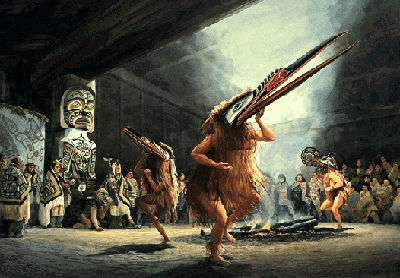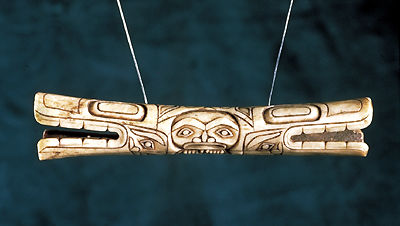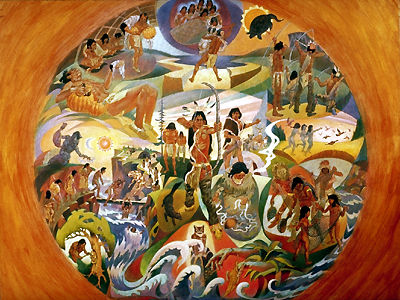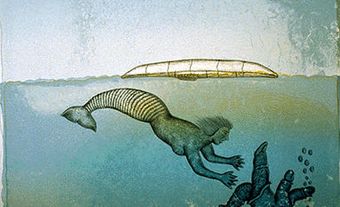Definition
There is no definitive and overarching “Indigenous religion.” Spiritual beliefs vary widely, as do the cultural practices of contemporary Indigenous peoples in Canada. However, there are commonalities among Indigenous spiritual traditions, including the presence of creation stories, the role of tricksters or of supernatural beings in folklore and the importance of sacred organizations. Additionally, traditional ways of life are often intermingled with religion and spirituality. Activities such as hunting, clan membership and other aspects of daily life may often be imbued with spiritual meaning. This article attempts to discuss broadly similar themes and practices, but is by no means exhaustive or authoritative. More specific information may be found through further reading, or the guidance of community elders.
Creation Stories
Creation stories describe the origins of the cosmos and the interrelations of its elements. Among these tales is what scholars often refer to as the “Earth Diver myth.” This is a story where a Great Spirit or cultural hero dives, or orders animals to dive, into the primeval water to bring back mud, out of which the Earth is fashioned. In some versions of the story, Earth is formed on the back of a turtle; Turtle Island is a popular name used by certain Indigenous peoples for the land of North America.
Creation stories also tell about the origin of the moon, the sun, the stars and human beings. These tales can act as histories and/or lessons about the environment, the heavens and human’s relationship to the world and to one another. In many of these stories, tricksters and transformers — beings with superhuman powers — often play an active role, as they help to create the world as we know it and to guide humanity.
Tricksters, Transformers and Culture Heroes
Tricksters take on a variety of forms in Indigenous cultures. They can be male or female, foolish or helpful, hero or troublemaker, half-human-half-spirit, old or young, a spirit, a human or an animal, depending on the area and the specific nation. Some examples of tricksters include Coyote (Mohawk), Nanabush or Nanabozo (Ojibwe) and Raven (Haida, Tsimshian, Tlingit, Inuit and Nisga’a).
Transformers or shape-shifters are beings that can change shape, from human to animal to inanimate object. One example of a transformer is Glooscap of the Mi’kmaq, Wolastoqiyik, Abenaki and Algonquian peoples. Glooscap formed the sun, moon, fish, animals and humans, whereas his brother Malsum (another transformer) created snakes, mountains, valleys and anything else he thought would make life difficult for humans.
Some Indigenous folklore also includes culture heroes, prominent figures in a particular nation’s spiritual beliefs. In some tales, these beings make a perilous journey to the realm of the dead to bring back a deceased loved one. These stories contain detailed characterizations of the land of the dead, and are important to an understanding of diverse phenomena, such as concepts of the soul and many aspects of shamanism. (See also Shaman.)
Religious Institutions and Practices
Different Indigenous nations have their own religious institutions and sacred practices. Many Plains Indigenous peoples participate in the Sun Dance, while Coast Salish peoples typically engage in sacred winter ceremonies. The Haudenosaunee celebrate the Green Corn Ceremony, and some follow the False Face Society. Among the Ojibwe, the Midewiwin is a spiritual society and essential part of the Anishinaabe world view. Medicine bundles — objects of ritual that are specific to the person carrying them — are common among the spiritual traditions of various Indigenous peoples, including the Siksika, Cree and Ojibwe.
Institution stories tell about the origins of these cultural practices. Ritual tales, on the other hand, serve as detailed texts for the performance of institutions, ceremonies and rituals. Fertility, birth, initiation and death rites are often clearly stipulated in spiritual traditions. Shamanic performances may also be described. Such ceremonies are often preceded by stringent purification rites, such as sweat lodges or baths (common for Salish, Siksika and Eastern Woodlands peoples), fasting and sexual abstinence. Feasting is also a common feature of these ceremonies.
Great Spirit and Worldviews
Many Indigenous peoples subscribe to the idea of a Creator, Great Spirit or Great Mystery — a power or being that has created the world and everything in it. These beings are often described as good or well-intentioned, though dangerous if treated carelessly or with disrespect.
Great spiritual power is also found in the spirits of all living things, natural phenomena and ritually significant places. In general, supernatural mystery or power is called Orenda by the Haudenosaunee, Wakan by the Dakota and Manitou by the Algonquian peoples. This power is a property of the spirits, but also belongs to transformers, tricksters, culture heroes, or other spirit figures, as well as shamans, prophets and ceremonial performers. Ritual objects such as the calumet, rattles, drums, masks, medicine wheels, medicine bundles and ritual sanctuaries are filled with spiritual power.
Various Indigenous oral histories tell of contacts made between humans and the world beyond. Ceremonially, columns of smoke, central house posts or the central pole of the Sun Dance lodge represent such connections. Many nations tell of a primeval sea or great flood. Northwest Coast peoples, such as the Kwakwaka’wakw, divide the year into two major seasons: the summer time and the winter time, in which most religious ceremonies take place. Historically agricultural societies such as the Haudenosaunee have ceremonial calendars organized around the harvest times of various food plants, with a life-renewal ceremony usually held in midwinter.
A key concept among many societies is the notion of guardians. Among the Abenaki, for instance, Bear is considered one of six directional guardians (west), representing courage, physical strength and bravery. Among the Inuit, the sea goddess Sedna is the guardian of sea mammals and controls when stocks are available to be hunted. Shamans may visit Sedna and coax her into releasing the animals by righting previous wrongs or presenting offerings.
Shamans
Shamans are the most notable of the multiple religious figures present in traditional Indigenous religion. They function as healers, prophets, diviners and custodians of religious mythology, and are often the officiants at religious ceremonies. In some societies, all these functions are performed by the same person; in others, shamans are specialists. Healing practitioners may belong to various orders, such as the Midewiwin or Great Medicine Society of the Ojibwe, while other groups had secret societies, such as the Kwakwaka’wakw and Siksika. Members of such societies were not necessarily shamans but did practice religious ceremonies and rituals.
Shamans were associated with powers generally thought to be beneficial to the community but were believed in some cases to use their powers for sorcery. Shaman-prophets and diviners were concerned with predicting the outcome of the hunt, relocating lost objects and determining the root causes of communal discontent and ill will. Siksika, Cree, Ojibwe and other societies had diviners who made their prophecies (perhaps in trance states) in the dramatic Shaking Tent ceremony. Shamans in these societies were custodians of the sacred medicine bundles containing objects and materials endowed with great mystery and power. Innu shamans divined game trails by burning a caribou shoulder blade, then reading the cracks and fissures created by the fire.
As healers, shamans typically recognized natural causes for many diseases, especially physically curable ones; other illnesses were commonly believed to be the result of intrusion into the body of objects placed there by sorcerers. The shaman-healer’s treatment of such diseases was dictated by his guardian spirit, but usually consisted of the shaman ritually sucking the disease agent out of the body, brushing it off with a bird’s wing, or drawing it out with dramatic gestures. Illness could also result from “spirit loss” — the loss of the soul and/or guardian spirit power. The shaman-healer’s action was then directed to recovering the patient’s spirit and reintroducing it to the body.
Guardian Spirit and Vision Quests
Vision quests (sometimes referred to as guardian spirit quests) once occurred throughout most Indigenous cultures in Canada; it has undergone a revival in many communities. Males, especially at puberty but also at other times of life, make extended stays in remote areas while fasting, praying and purifying themselves by washing in streams and pools. The goal is to seek a vision of, or an actual encounter with, a guardian spirit — very frequently an animal, but possibly a mythological figure. Contact with a guardian spirit is believed to make an individual healthy, prosperous and successful, particularly in hunting and fishing.
The individual focus of the quest is also present in common celebration of life events. Among these rituals are ceremonies at birth or the giving of a name, at puberty, marriage and death, all of which are normally accompanied by some solemnity. Life-event ceremonies, though individual, had some level of communal integration. For example, the 17th-century Huron-Wendat Feast of the Dead may have incorporated features of both seasonal and life-crisis rituals.
European and Christian Influence
Contact with European religious systems — through settlers, missionaries, church- and government-sponsored residential schools, and direct and indirect government policy — brought change to all Indigenous religious forms.
In areas where sustained contact occurred relatively early — in the 16th and 17th centuries — many Indigenous peoples were baptized into Catholicism by French missionaries. The Mi’kmaq, for instance, began their conversion to subjects of the Vatican after the conversion of Grand Chief Membertou in 1610. Mi’kmaq religion incorporates many traditional aspects in fusion with Christianity, even the flag for the Mi’kmaq Grand Council features a large cross.
The adaptability of Christianity to Indigenous spirituality is evident in the Huron Carol — a Christmas carol purportedly written for the Huron-Wendat by Jesuit missionary Jean de Brébeuf in the 17th century. The song fuses Indigenous imagery and mythology — including Kitchi Manitou — onto the Christian Nativity story. Wise men bearing gifts become grand chiefs bearing pelts, and the manger becomes a lodge of birch bark. The stories of saints, and of Jesus, closely resembled familiar culture heroes, and were readily adapted in many Indigenous communities.
Intermarriage was a more literal merging of religious and spiritual traditions, and Métis religious practices typically combine traditional spirituality with either Protestant or Catholic customs. Some unique belief systems combine traditional Indigenous forms with European observances, such as the Shaker Religion of the Coast Salish area.
Adaptation to European religion and ways of life was not smooth or without consequence. While some Indigenous peoples rejected early conversion attempts, generations suffered under destructive government policies such as residential schools and the outlawing of the potlatch and Sun Dance under the Indian Act in 1885.
Some First Nations rejected European forms and turned to traditional spirituality to revive previous religious practices and beliefs (e.g., the Haudenosaunee Handsome Lake Religion). Other religious movements radically opposed European forms, such as the 19th-century Ghost Dance of the Dakota and other Plains communities.
The divide between Christian and non-Christian peoples remains an issue of tension. In 2011, the Cree First Nation of Oujé-Bougoumou, headed by an all-Christian council, outlawed all expressions of Indigenous spirituality, including sweat lodges, which prompted backlash and division within the community. In 2015, it was reported that Ouje-Bougoumou held its first powwow event, a type of gathering not typically encouraged in the past.

 Share on Facebook
Share on Facebook Share on X
Share on X Share by Email
Share by Email Share on Google Classroom
Share on Google Classroom










